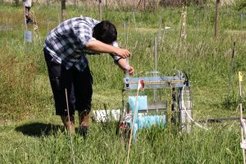Jena Experiment will go on
The continuation of one of the largest and oldest biodiversity experiments in Europe has been secured until May 2018. The German Research Foundation (DFG) will continue to fund the Jena Experiment over the next two years and is providing around four million euros to investigate various aspects of biodiversity on an area on the outskirts of Jena. Friedrich Schiller University Jena will receive around 1.5 million euros and Leipzig University around 800,000 euros. In total, over 100 researchers are involved in the Jena Experiment - including from the German Center for Integrative Biodiversity Research (iDiv), which is now the spokesperson for the experiment.

„What distinguishes the Jena Experiment is that different research groups work on the same areas. They are interested in topics as diverse as pollination, the interactions between soil organisms and above-ground plant parts, and nitrogen and carbon cycles. Or they work with computer models. This allows us to draw a comprehensive picture of the effects of these manipulations of biodiversity – and to do so over long periods of time," reports Dr. Anne Ebeling from the Friedrich Schiller University Jena, who coordinates the infrastructure and the work on site. "The long-term data series are the heart of the Jena Experiment and are used by all participants as well as by external international scientists," says Ebeling. This has resulted in over 185 scientific publications to date, including several in renowned journals such as Nature and Science. Last year alone, researchers were able to show, for example, that biodiversity protects ecosystems from climate extremes (Nature), that species-rich grasslands grow better after flood disasters than species-poor ones (Nature Communications), and that plant diversity increases the activity of microorganisms and carbon storage in the soil (Nature Communications)..
In September 2015, the entire project was evaluated by the DFG for the sixth time by international reviewers on site. Now the news has come that the experiment will be funded for a further two years. The new project phase will focus primarily on the synthesis of data and meta-analyses, for which extensive data series from recent years will be used. In addition, closer cooperation is planned with other DFG field experiments such as the three German biodiversity exploratories Schorfheide-Chorin (Brandenburg), Hainich-Dün (Thuringia) and Schwäbische Alb (Baden-Württemberg), with the AquaDiva Collaborative Research Center in Jena, with BEF China and with comparable large-scale experiments in the USA.
In addition, there will be another large-scale joint field experiment in Jena in 2016/17 to better understand the relationships between biodiversity and various ecosystem functions. "It is now known that these relationships intensify over the years, but we still know little about the mechanisms behind this observation. We therefore want to find out how biological and non-biological factors, as well as the interactions between plants and organisms in the soil, interact to produce this effect," explains Prof. Nico Eisenhauer from the University of Leipzig and the German Centre for Integrative Biodiversity Research iDiv. Eisenhauer has been involved in the experiment from the very beginning. Last year, he took over the role of spokesperson from Prof. Wolfgang Weisser, who now conducts research at the Technical University of Munich. As scientific director, the spokesperson is responsible for a total of nine subprojects involving 14 research institutions, including iDiv partners such as the Helmholtz Centre for Environmental Research (UFZ), the Max Planck Institute for Biogeochemistry in Jena, and the Martin Luther University Halle-Wittenberg (MLU), as well as universities from Switzerland and the Netherlands. The Max Planck Institute for Biogeochemistry will continue to provide ongoing technical support for the initial installations. Tilo Arnhold/ Tabea Turrini
